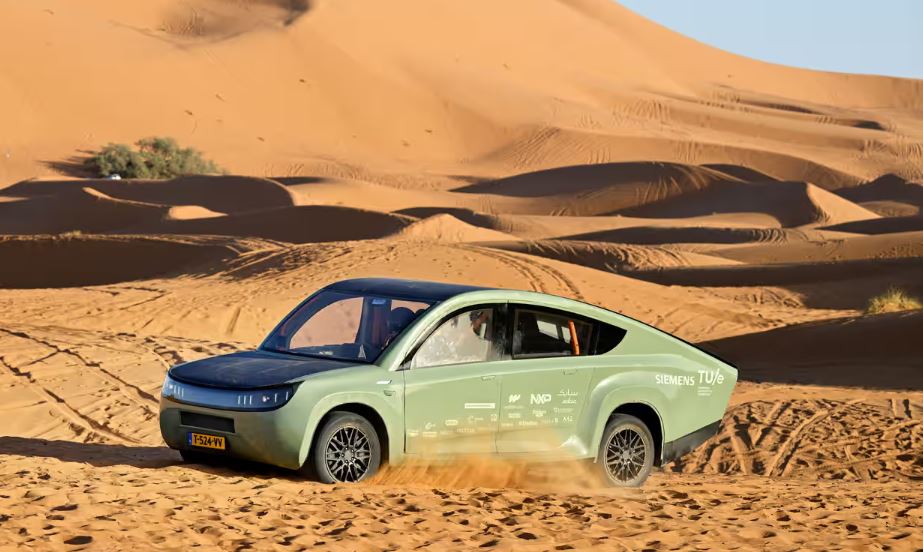A groundbreaking solar-powered car, the Stella Terra, touted as the world’s first long-distance off-road vehicle of its kind, has successfully completed a demanding 620-mile (1,000km) test drive across Morocco and the Sahara. This pioneering project was developed by a group of 22 students from the Eindhoven University of Technology.
Read also: Mercedes-Benz, Google partner to improve Digital Technologies for cars
Trailblazing Sustainability in Mobility
The Stella Terra, a two-seat marvel of engineering, demonstrated its capabilities over a range of challenging landscapes during its expedition, serving as a final validation of its lightweight structure and aerodynamic design. Propelled by the energy harnessed from its multiple rooftop solar panels, this remarkable vehicle attains a top speed of 90mph (145kmph). Remarkably, it weighs a mere 1,200kg (1.2 tonnes) and boasts a sunny-day range of at least 440 miles (710km).
Wisse Bos, team manager of Solar Team Eindhoven, proudly asserted that the technology employed in the Stella Terra, combining a lightweight frame with highly efficient solar panels, stands a decade ahead of anything available in the market. He declared, “Stella Terra must withstand the harsh conditions of off-roading while remaining efficient and light enough to be powered by the sun. That is why we had to design almost everything for Stella Terra ourselves, from the suspension to the inverters for the solar panels. We are pushing the boundaries of technology.”
The vehicle includes a rechargeable lithium-ion battery, offering versatility for operation in less sunny climates over shorter distances. Its solar panels provide an exceptional surplus of electricity, facilitating additional uses such as cooking and charging devices like phones and cameras.
The 22 students who brought the Stella Terra to life, aged between 21 and 25, dedicated a year to this project. While they encountered some hiccups during their week-and-a-half-long desert expedition, such as a steering system issue, the vehicle’s resilience shone through. The technical manager, Bob van Ginkel, shared, “We hope this can be an inspiration to car manufacturers such as Land Rover and BMW to make it a more sustainable industry. The car was actually very comfortable in the off-road conditions as it is very light and does not get stuck.”
A bespoke converter for the solar panels was discovered to be a staggering 97% efficient in converting absorbed sunlight into electrical power. Stella Terra demonstrated a remarkable 33% improvement in efficiency compared to the original expectations.
Challenges and Opportunities for the Solar Car Revolution
Designing solar-powered cars faces the challenge of limited surface area for solar panels. Highly efficient panels, capable of powering vehicles over long distances, tend to be costly. Existing panels typically offer around 15% to 20% efficiency, with the most efficient reaching approximately 45%. The Stella Terra project, which is nonprofit and dependent on sponsors for funding, signifies a step towards innovation in this sphere.
For companies like Atlas Technologies, a subsidiary of the Netherlands-based Lightyear, manufacturing costs have been a stumbling block. Last year, Atlas Technologies aimed to produce solar-electric cars at a price of €500,000 per vehicle, but the lack of orders led to the company’s bankruptcy. However, the company has reemerged with a new model priced at $40,000, offering a travel range of about 500 miles between charges, illustrating the evolving landscape of solar mobility.
Pioneering a Sustainable Future
The successful Sahara test drive of the Stella Terra reflects a significant leap in sustainable transportation. The commitment of these visionary students to push the boundaries of technology and explore the possibilities of solar-powered mobility could serve as a source of inspiration for larger automobile manufacturers. As the world strives towards a more sustainable future, innovations such as the Stella Terra contribute to the vision of eco-friendly, long-range, solar-powered vehicles.




